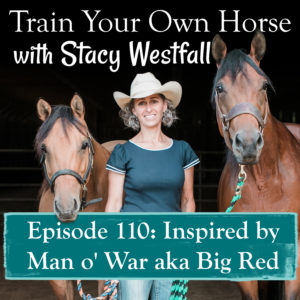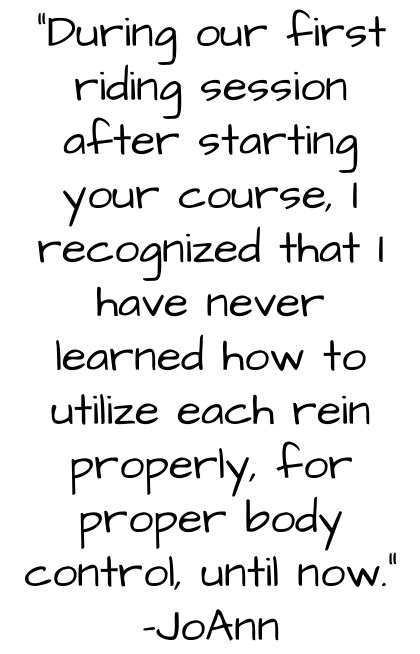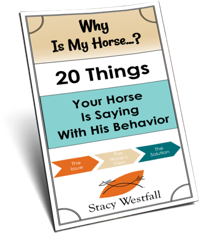Episode 110: Inspired by Man o’ War aka Big Red
December 23, 2020/

Which horse first inspired you? The earliest memory I have of being inspired by a real horse was my mom, reading stories to me of Man O War aka Big Red.
Stories like these gave me a glimpse into a world filled with horses. The authors wrote of horses with heart and ‘the look of eagles.’ In this podcast, I share with you some of the stories that inspired me.
C.W.Anderson, Favorite Horse Stories, click to see on Amazon
17 Comments
Leave a Comment
SUBSCRIBE TO THE PODCAST HERE:





YOURS FREE
WHY IS MY HORSE...?


I am late to listen to this. Oh my goodness. C W Anderson is my favorite horse author and influenced my life too! I have a degree in art but am a teacher now. Thank you. This made my day. I own all of the Anderson books.
I have learned from “evidence-based horsemanship” by Steven Peters & Martin Black. But I’m most interested in the adventures of Filipe Masetti-Leite Book 1 is his long ride from Calgary, Can to Brazil. And book 2 is his second long ride from Brazil to Tierre del Fuego! I’m stuck in a leg cast for the winter so please make your book suggestions!
That was absolutely beautiful! My horse Artfully Regal, AKA Moe, has Man O’ War as his great great great great grandfather and I swear they have the exact same eyes and facial expressions!
Thank you for sharing this. Such a beautiful story and beautiful presentation.
My favorite book was actually The Black Stallion series. I read all of them several times during my elementary school years. I looked forward to library time each week, when I hoped with all hope that the next book in the series would be available for check out. I loved that horse with all my heart and dreamed dreams of riding him. It all seemed so real, that I could even smell the salt of the ocean, as I dreamed of us running along the beach…As an adult, I was thrilled to see they were still in print, even though it was in paperback. I bought them up and later donated to the school library where I taught, so that another little girl could dream of one day spending her days with her own horse…just like I have. While my horses have never been a black stallion, I loved them just as much.
Deanna, You’re the winner of the extra book I ordered, CW Anderson’s Favorite Horse Stories. I’ll send you an email right now to get your address. I hope you enjoy!
I can’t remember NOT loving horses. I devoured every book I could find at our local library and at my school. We had “Billy & Blaze” books. I absolutely loved them!
I still have many of my childhood horse books.
“Smoky the Cowhorse” was one of my all time favorites as I grew up, I still read it and have several copies of it.
I started asking for a pony when I was three but a horse was not feasible for our family. I lived vicariously through National Velvet, Misty, The Black and any book that had a horse on the cover all through grade school. I was 13 when James Herriot’s All Creatures Great and Small came out and I fell in love with his real-life experiences. I still enjoy reading stories about horses but my favorite books are the ones where I’m learning something. That’s why I like your podcast so much too. By the way, I bought the pony, a fabulous 13.3 Paso Fino mare, when I was 52 and haven’t looked back. She was joined by an almost 14.3 Paso Fino gelding s years ago so I’ve finally graduated to a horse! <3
The Misty of Chincoteague books by Marguerite Henry and the Black stallion books by Walter Farley were my best friends. I was obsessed with horses and did all I could to feed that appetite. I think it all helped me cope as a kid…
When I was little my brother and I had a pony to share, a shetlsnd that lived up to every story you heard about a shetland pony. One day she got into the stud stall. That foal was mine. My dad believed in equal treatment and bred the pony back for my brother. His favourite books were the Billy and Blaze stories so this foal was called blaze before it even made an apearance. I am sure he willed it to be brown with a blaze. My brother’s name was Bill. My pony was grey and the next foal was grey both like their dad. Blaze the only brown. Billy and Blaze had many of their own adventures after he read all the C. W. Anderson books to her. I think I am on a new quest. I need to find a book for him. Thank you for the trip down mrmory lane.
Stacy-
Thank you so much for your gift of sharing Man O War aka Big Red with us on Christmas week. What a delight to hear you read to us! My Mom inspired a love for horses with me and I currently own two. Your podcast has helped me tremendously in my confidence with my own horses and reinforces that I am on the right track most of the time when my intuition is tapping me on the shoulder, if I would only listen.
The story that this brought to mind for me is actually a poem titled The Blood Horse (you can find it here if you wish to read it https://www.poemhunter.com/poem/the-blood-horse/). I always loved horses as a child and I have always loved to read. This poem was the first poem that I memorized, inspired because it was about a horse. Thank you again, this was lovely, absolutely lovely. All the best Stacy.
Hi Stacy!
I had forgotten all about Billy and Blaze, and now I am wanting to go digging through everything at my parent’s place to try and find my old books. Like you I loved to be read to, or told stories when I was younger. When I was old enough to read myself I did so every free moment when I wasn’t doing chores or riding. Thank you for reading this story today, it was really well read and definitely took me back. I would also really love to read that book you were able to find with the picture of your pony inside, it sounds like the BEST. Merry Christmas! And thank you so much for your thoughtful content.
I absolutely loved this episode, it really hit me in the feels. It brought me back to being a horse crazy little girl and being obsessed with anything horse and true real ness about the love of the sport and animal
Wow Stacy, you took me way back to reading horse books as a child like My Friend Flicka and National Velvet among many others! Those books were read by my children and now my grandchildren are reading them! Thank you so much for putting such time and thoughtfulness in all your podcasts and then this week changing things up and making us reflect back on such wonderful memories!
Wow. I started listening this morning but had to pause it to go do things. I thought about it throughout the day. I couldn’t wait to finish things and log back on and listen to the rest. I didn’t know about Man of War – Big Red. I thought Big Red was given to Secretariat. Thank You So Much Stacy. This was beautiful. Just beautiful.
Stacy you brought tears to my eyes. I learned to ride from my grandparents and my grandmother used to read horse stories to me. This reminded me of that so much!
My dad introduced me to horses at the age of four. Our neighbor’s property backed up to ours so I could see them daily. By the time I was eight years old, I would physically run to the barn to hold, pet and groom horses nearly every day. It was all “back yard fun”, but my love and respect for horses was in me and has never left. When I had saved up enough money from babysitting and working at Wendy’s Hamburgers, I bought and boarded my own horse at age 16 at that same barn. I owned Fawn for 17 years where we gave rides to neighbors and friends. We rode through streams and in lakes, through neighborhoods and fields. We raced motorcycles and freight trains. I cashed paychecks in drive through lanes at the bank and would get ? carrots from the salad ? bar at the Burger King drive thru. I always felt like royalty when riding her. She was my freedom, my joy, my pleasure, my best friend.
I now own two more horses, each with their own rich story. We have made countless memories and conquered new frontiers including re-introducing shoreline horseback riding at Silver Lake State Park along the Lake Michigan shoreline. We hope you can join us sometime!